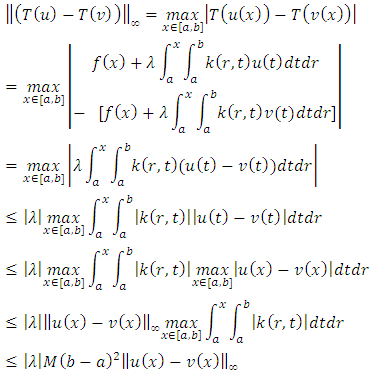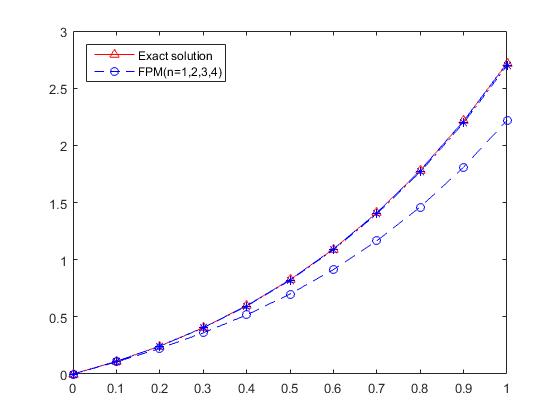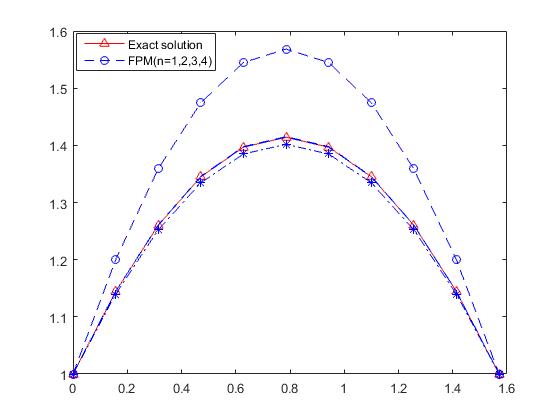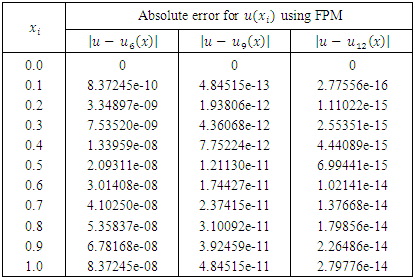-
Paper Information
- Paper Submission
-
Journal Information
- About This Journal
- Editorial Board
- Current Issue
- Archive
- Author Guidelines
- Contact Us
American Journal of Computational and Applied Mathematics
p-ISSN: 2165-8935 e-ISSN: 2165-8943
2019; 9(1): 1-5
doi:10.5923/j.ajcam.20190901.01

Existence and Uniqueness of Solution for Linear Mixed Volterra-Fredholm Integral Equations in Banach Space
Pakhshan Mohammed Ameen Hasan, Nejmaddin Abdulla Sulaiman
Department of Mathematics, College of Education, Salahaddin University-Hawler, Erbil, Iraq
Correspondence to: Pakhshan Mohammed Ameen Hasan, Department of Mathematics, College of Education, Salahaddin University-Hawler, Erbil, Iraq.
| Email: |  |
Copyright © 2019 The Author(s). Published by Scientific & Academic Publishing.
This work is licensed under the Creative Commons Attribution International License (CC BY).
http://creativecommons.org/licenses/by/4.0/

In this paper, the existence and uniqueness of mixed linear Volterra-Fredholm integral equations of the second kind will be studied under some conditions in the Banach space and Fixed-point theory. Also approximate solution is presented using fixed-point iteration method (FPM), and then the Aitken method is used to accelerate the convergence. For more illustration the method is applied on several examples and programs are written in the Matlab to compute the results. The absolute errors are computed to clarify the efficiency of the method.
Keywords: Fixed point method, Contraction mapping, Aitken method, Second kind linear mixed Volterra-Fredholm integral equation (LMVFIE2nd)
Cite this paper: Pakhshan Mohammed Ameen Hasan, Nejmaddin Abdulla Sulaiman, Existence and Uniqueness of Solution for Linear Mixed Volterra-Fredholm Integral Equations in Banach Space, American Journal of Computational and Applied Mathematics , Vol. 9 No. 1, 2019, pp. 1-5. doi: 10.5923/j.ajcam.20190901.01.
Article Outline
1. Introduction
- Volterra-Fredholm Integral equations have received significant meaning in the mathematical physics, biology, engineering, and contact problems in the theory of elasticity [14, 6]. These types of equations can be solved analytically in [1, 5]. At the same time, the sensing of numerical methods takes an important place in solving them [7, 15].In the present work, we consider a mixed Volterra-Fredholm integral equation of the second kind of the form
 | (1) |
 is continuous on the interval
is continuous on the interval  and
and  is continuous on
is continuous on  , while u(x) is the unknown continuous function in
, while u(x) is the unknown continuous function in  to be determined.Ahmed solved this equation by using least square approximation method, [12]. Wazwaz solved this problem by using the method of series solution and the Adomian decomposition method, [3]. In [10], Ezzati and Najafalizadeh used Cas wavelets for solving linear and nonlinear Volterra-Fredholm integral equations. In [9] Wang used least square approximation method to solve this type of equation. In addition, Ibrahim used new iterative method for solving the linear Volterra-Fredholm and mixed Volterra-Fredholm integral equations in [4]. Also, Hasan solved it by using linear programming method, [8].The objective of this work is to study the existence and uniqueness of solution of equation (1), also to present an approximate solution using fixed point iteration method, and then the Aitken method is used to accelerate the convergence of the solution.
to be determined.Ahmed solved this equation by using least square approximation method, [12]. Wazwaz solved this problem by using the method of series solution and the Adomian decomposition method, [3]. In [10], Ezzati and Najafalizadeh used Cas wavelets for solving linear and nonlinear Volterra-Fredholm integral equations. In [9] Wang used least square approximation method to solve this type of equation. In addition, Ibrahim used new iterative method for solving the linear Volterra-Fredholm and mixed Volterra-Fredholm integral equations in [4]. Also, Hasan solved it by using linear programming method, [8].The objective of this work is to study the existence and uniqueness of solution of equation (1), also to present an approximate solution using fixed point iteration method, and then the Aitken method is used to accelerate the convergence of the solution.2. Definitions and Theores [11, 2]
- This section deals with some definitions and theorems which are used in this workDefinition 2.1. Let
 be a metric space and
be a metric space and  with the mapping
with the mapping  an element
an element  is a fixed point of the mapping f if
is a fixed point of the mapping f if  .Definition 2.2. Let
.Definition 2.2. Let  be a complete metric space, the mapping
be a complete metric space, the mapping  is called contractive mapping if there is a real number
is called contractive mapping if there is a real number  such that for each
such that for each  we have
we have Definition 2.3. Assume that
Definition 2.3. Assume that  is linearly convergent sequence to the limit p, then the sequence
is linearly convergent sequence to the limit p, then the sequence  that constructed by the acceleration (Aitken) formula
that constructed by the acceleration (Aitken) formula , converges to p more rapidly than does the original sequence
, converges to p more rapidly than does the original sequence  .Theorem 2.1. Let
.Theorem 2.1. Let  be a complete metric space and
be a complete metric space and  be a contractive mapping on M, then f has a unique fixed point. Moreover, for any
be a contractive mapping on M, then f has a unique fixed point. Moreover, for any  the sequence of iterates
the sequence of iterates  converges to a fixed point of f.Theorem 2.2. Let
converges to a fixed point of f.Theorem 2.2. Let  be any sequence converging linearly to the limit p with
be any sequence converging linearly to the limit p with  . The sequence
. The sequence  converges to p faster than
converges to p faster than  in the sense
in the sense  .
.3. The Application of Fixed Point Method (FPM) on LMVFIE2nd
- We consider the mixed Volterra-Fredholm integral equation (1.1) and define the operator T as follows
 | (2) |
 , the following fixed-point iteration will be introduced
, the following fixed-point iteration will be introduced | (3) |
 will be determined by using equation (3.2), then the sequence of approximate solutions
will be determined by using equation (3.2), then the sequence of approximate solutions  will be produced which approaches the exact solution u as n approaches infinity. It is just the contractive property which is responsible for clustering the sequence
will be produced which approaches the exact solution u as n approaches infinity. It is just the contractive property which is responsible for clustering the sequence  in toward a limit point. Therefore the main concepts that are needed for fixed-point theorem are a complete metric space and a contractive mapping which would ensure the existence of a unique solution for the presented equation.In the following, we show that under proper assumptions, T becomes a contractive mapping.Theorem 3.1. Let
in toward a limit point. Therefore the main concepts that are needed for fixed-point theorem are a complete metric space and a contractive mapping which would ensure the existence of a unique solution for the presented equation.In the following, we show that under proper assumptions, T becomes a contractive mapping.Theorem 3.1. Let  be a complete metric space, and the functions k and f be continuous in their respective domain i.e.
be a complete metric space, and the functions k and f be continuous in their respective domain i.e.  and
and  , if additionally the following inequality
, if additionally the following inequality | (4) |
 for some positive real number M.Let
for some positive real number M.Let  , then
, then Then with the assumption
Then with the assumption  we get that
we get that  .Consequently, the mapping T of the linear Volterra-Fredholm integral equation becomes a contractive mapping.
.Consequently, the mapping T of the linear Volterra-Fredholm integral equation becomes a contractive mapping. 4. The Existence and Uniqueness of Solution
- To ensure the existence of a unique solution of the MVFIE2nd, we have to show that T has a unique fixed-point and the sequence
 generated by iteration (3) converges to this unique fixed-point.Theorem 4.1. Let
generated by iteration (3) converges to this unique fixed-point.Theorem 4.1. Let  be a complete metric space and T be a contractive mapping of MVFIE2nd defined in (3)theni. T has a unique fixed-point
be a complete metric space and T be a contractive mapping of MVFIE2nd defined in (3)theni. T has a unique fixed-point  ii. For any
ii. For any  the sequence of iterates
the sequence of iterates converges to
converges to  .Proof: i. By taking the limit of both sides of
.Proof: i. By taking the limit of both sides of 
 Since T is contraction mapping, then it is continuous, so
Since T is contraction mapping, then it is continuous, so Thus
Thus  . Hence T has a fixed-point.Now, suppose that
. Hence T has a fixed-point.Now, suppose that  is also a fixed-point of T, that is
is also a fixed-point of T, that is 
 Remembering that
Remembering that  , the above implies that
, the above implies that  This means that
This means that  , which is contradicts our assumption, therefore
, which is contradicts our assumption, therefore  .ii. By the closer condition from part (i), we have:
.ii. By the closer condition from part (i), we have: also we have
also we have that is we get
that is we get Taking the limit of both sides produces
Taking the limit of both sides produces Since
Since  , then
, then  , as
, as  , that is
, that is  .
.5. The FPM Algorithm
- To find an approximate solution of (LMVFIE2nd) by FPM perform the following steps:Step 1: select positive integers a, b, and n.Step 2: put
 as an initial approximation.Step 3: calculate
as an initial approximation.Step 3: calculate  in equation (3) for all
in equation (3) for all  .Step 4: increment i and repeat the previous step until desired level of accuracy is reached.Step 5: find
.Step 4: increment i and repeat the previous step until desired level of accuracy is reached.Step 5: find  .Step 6: compute the absolute error of each root
.Step 6: compute the absolute error of each root  .
.6. Acceleration of Approximation (Aitken)
- In this section, the possibility of improving the rate of convergence will be discussed for a slowly convergent sequence of iterates. The approach we adopt is due to Aitken. The idea is to use the terms of the sequence and their rate of change to predict the future behavior of the iteration. The proses are applicable to any linearly convergence.Suppose that the sequence
 is linearly convergent to the limit u. It follow that there exists a constant c, with
is linearly convergent to the limit u. It follow that there exists a constant c, with  , such that for sufficiently large value of n,
, such that for sufficiently large value of n, | (5) |
 . It can be deduced that
. It can be deduced that we find that
we find that | (6) |
 and the errors
and the errors  by
by  . It will be found that the sequence
. It will be found that the sequence  is also convergent with the same limit u, but with a noticeably better approximation and faster rate of convergence as it stated in theorem (2.1).
is also convergent with the same limit u, but with a noticeably better approximation and faster rate of convergence as it stated in theorem (2.1).7. Aitken on FPM for Solving MVFIE2nd
- In this section, the Aitken's method has been applied successfully on fixed-point method to find the solution of our integral equation, where the first three approximations are computed by fixed-point method and then substituted in equation (6) to get the procedure
 | (7) |
8. Numerical Examples
- In this section, several examples will be solved to show the accuracy of our approach.Example 1. Consider the following LMVFIE2nd
 where
where  is the exact solution.Assume that f(x) is continuous on
is the exact solution.Assume that f(x) is continuous on  , and
, and  is continuous on the square
is continuous on the square  , hence it is bounded there and a bound
, hence it is bounded there and a bound  is 1, that is
is 1, that is , also we have
, also we have So according to the above theorem the problem has a unique solution and as described above, first we let
So according to the above theorem the problem has a unique solution and as described above, first we let  , and then
, and then  will be determined. By choosing different values of (n), we will get the results that are listed in Table 1, while Figure 1 gives a comparison between the exact and the approximate solution using (F.P.) solution for different values of n.
will be determined. By choosing different values of (n), we will get the results that are listed in Table 1, while Figure 1 gives a comparison between the exact and the approximate solution using (F.P.) solution for different values of n.
|
 | Figure 1. Exact solutions and numerical results of example 1 using (F.P.) for n=1, 2, 3, and 4 |
 and
and  will be found by FPM as follows:
will be found by FPM as follows: and
and and then substituted them in the Aitken procedure to get
and then substituted them in the Aitken procedure to get  which gives the exact solution with only one iteration.Example 2. Consider the following LMVFIE2nd
which gives the exact solution with only one iteration.Example 2. Consider the following LMVFIE2nd where exact solution is
where exact solution is  .First, it will be verified whether the described method can be used for solving this problem. Since
.First, it will be verified whether the described method can be used for solving this problem. Since  and
and  , therefore we only check the satisfying of inequality (10). In this example
, therefore we only check the satisfying of inequality (10). In this example  and
and 
 This means that FPM can be applied, Let
This means that FPM can be applied, Let  , Applying the algorithm of the FPM with different values of n the following results that are listed in Table 2 are obtained, while Figure 2 gives a comparison between the exact and the approximate solution using (F.P.) solution for different values of n.
, Applying the algorithm of the FPM with different values of n the following results that are listed in Table 2 are obtained, while Figure 2 gives a comparison between the exact and the approximate solution using (F.P.) solution for different values of n.
|
 | Figure 2. Exact solutions and numerical results of example 2 using (F.P.) for n=1, 2, 3, and 4 |
9. Conclusions
- In this paper, the existence and uniqueness of solution of linear mixed Volterra-Fredholm integral equation of the second kind (LSMVFIE2nd) is verified and proved, the result is obtained by the help of some extensions of Banach's contraction principle in complete metric space. The fixed-point method introduced to solve the mentioned equation and then the solution is accelerated by Aitken formula. Two examples are presented for illustration and good approximate results are found. Moreover, the results of both of them (FPM & Aitken) are compared to each other and then with the exact solutions to demonstrate the implementation of the method. The given numerical examples and the outcomes in Tables (1-2) and Figures (1-2) are supported these claims.
 Abstract
Abstract Reference
Reference Full-Text PDF
Full-Text PDF Full-text HTML
Full-text HTML
